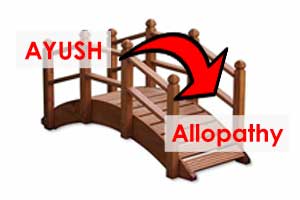 A contentious element of the National Medical Commission (NMC) Bill 2017 — an attempt to revamp the medical education system in India to ensure an adequate supply of quality medical professionals — has been Section 49, Subsection 4 that proposes a joint sitting of the Commission, the Central Council of Homoeopathy and the Central Council of Indian Medicine. This sitting, referred to in Subsection 1, may “decide on approving specific bridge course that may be introduced for the practitioners of Homoeopathy and of Indian Systems of Medicine to enable them to prescribe such modern medicines at such level as may be prescribed.”
A contentious element of the National Medical Commission (NMC) Bill 2017 — an attempt to revamp the medical education system in India to ensure an adequate supply of quality medical professionals — has been Section 49, Subsection 4 that proposes a joint sitting of the Commission, the Central Council of Homoeopathy and the Central Council of Indian Medicine. This sitting, referred to in Subsection 1, may “decide on approving specific bridge course that may be introduced for the practitioners of Homoeopathy and of Indian Systems of Medicine to enable them to prescribe such modern medicines at such level as may be prescribed.”
Missing the reality
The debates around this issue have been ranging from writing-off the ability of Ayurveda, yoga and naturopathy, Unani, Siddha and homoeopathy (AYUSH) practitioners to cross-practise to highlighting current restrictions on allopathic practitioners from practising higher levels of caregiving. However, these debates miss the reality: which is a primary health system that is struggling with a below-par national physician-patient ratio (0.76 per 1,000 population, amongst the lowest in the world) due to a paucity of MBBS-trained primary-care physicians and the unwillingness of existing MBBS-trained physicians to serve remote/rural populations. Urban-rural disparities in physician availability in the face of an increasing burden of chronic diseases make health care in India both inequitable and expensive.
Therefore, there is an urgent need for a trained cadre to provide accessible primary-care services that cover minor ailments, health promotion services, risk screening for early disease detection and appropriate referral linkages, and ensure that people receive care at a community level when they need it.
Issue of cross-prescription
The issue of AYUSH cross-prescription has been a part of public health and policy discourse for over a decade, with the National Health Policy (NHP) 2017 calling for multi-dimensional mainstreaming of AYUSH physicians. There were 7.7 lakh registered AYUSH practitioners in 2016, according to National Health Profile 2017 data. Their current academic training also includes a conventional biomedical syllabus covering anatomy, physiology, pathology and biochemistry. Efforts to gather evidence on the capacity of licensed and bridge-trained AYUSH physicians to function as primary-care physicians have been under way in diverse field settings, and the call for a structured, capacity-building mechanism is merely the next logical step.
The 4th Common Review Mission Report 2010 of the National Health Mission reports the utilisation of AYUSH physicians as medical officers in primary health centres (PHCs) in Assam, Chhattisgarh, Maharashtra, Madhya Pradesh and Uttarakhand as a human resource rationalisation strategy. In some cases, it was noted that while the supply of AYUSH physicians was high, a lack of appropriate training in allopathic drug dispensation was a deterrent to their utilisation in primary-care settings. Similarly, the 2013 Shailaja Chandra report on the status of Indian medicine and folk healing, commissioned by the Ministry of Health and Family Welfare, noted several instances in States where National Rural Health Mission-recruited AYUSH physicians were the sole care providers in PHCs and called for the appropriate skilling of this cadre to meet the demand for acute and emergency care at the primary level.
Our own experience at the IKP Centre for Technologies in Public Health shows that there is hope. Here, the focus has been on deploying a capacity-building strategy using AYUSH physicians upskilled through a bridge-training programme, and the use of evidence-based protocols, supported by technology, to deliver quality, standardised primary health care to rural populations. Protocols cover minor acute ailments such as fever, upper respiratory tract infections, gastrointestinal conditions (diarrhoea, acidity), urological conditions, as well as proactive risk-screening. The Maharashtra government has led the way in implementing bridge training for capacity-building of licensed homoeopathy practitioners to cross-prescribe.
As anchors
Capacity-building of licensed AYUSH practitioners through bridge training to meet India’s primary care needs is only one of the multi-pronged efforts required to meet the objective of achieving universal health coverage set out in NHP 2017. Current capacity-building efforts include other non-MBBS personnel such as nurses, auxiliary nurse midwives and rural medical assistants, thereby creating a cadre of mid-level service providers as anchors for the provision of comprehensive primary-care services at the proposed health and wellness centres. Further, the existing practice of using AYUSH physicians as medical officers in guideline-based national health programmes, a location-specific availability of this cadre to ensure uninterrupted care provision in certain resource-limited settings, as well as their current academic training that has primed them for cross-disciplinary learning hold promise. These provide a sufficient basis to explore the proposal of bridging their training to “enable them to prescribe such modern medicines at such level as may be prescribed”.
Ensuing discussions will be well served to focus on substantive aspects of this solution: design and scope of the programme, implementation, monitoring and audit mechanisms, technology support, and the legal and regulatory framework. In the long run, a pluralistic and integrated medical system for India remains a solution worth exploring for both effective primary-care delivery and prevention of chronic and infectious diseases.
Authors: Aparna Manoharan and Rajiv Lochan are involved with the IKP Centre for Technologies in Public Health; Rajiv Lochan is MD and CEO of The Hindu Group





